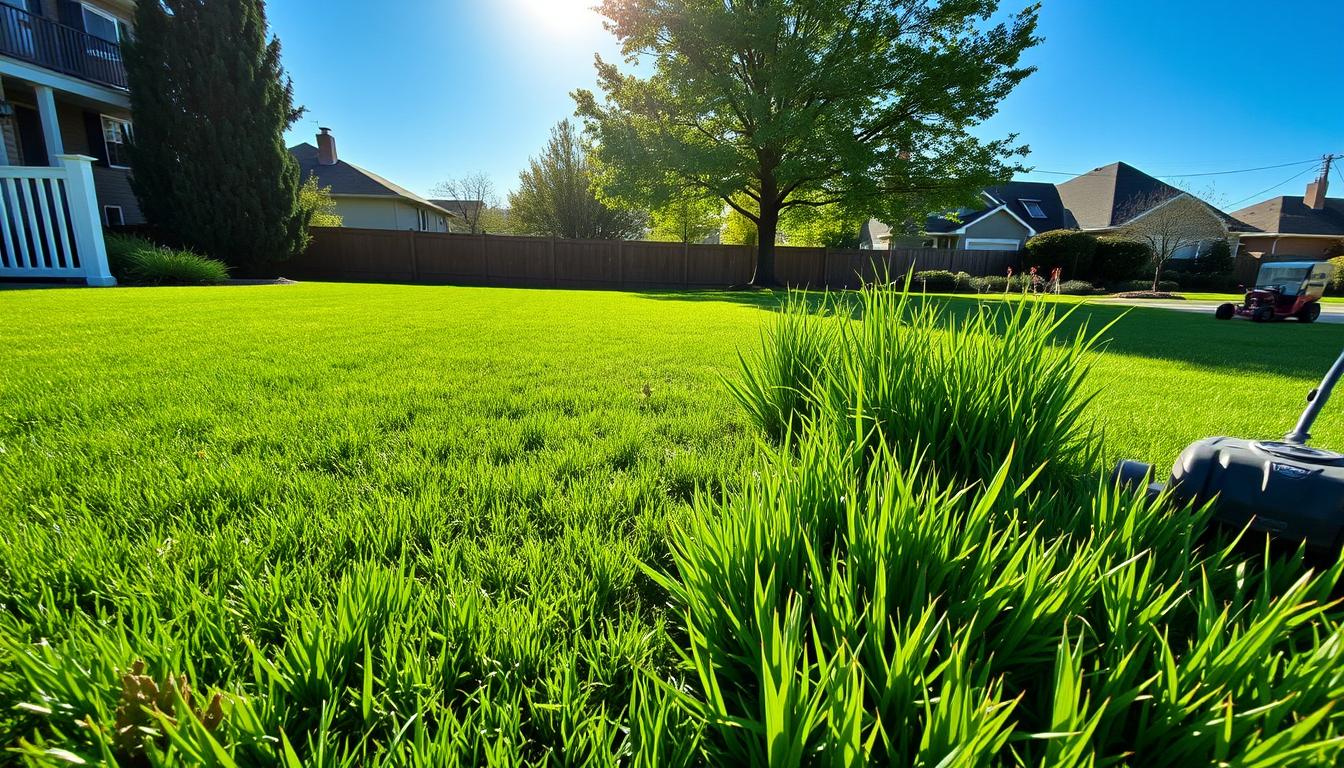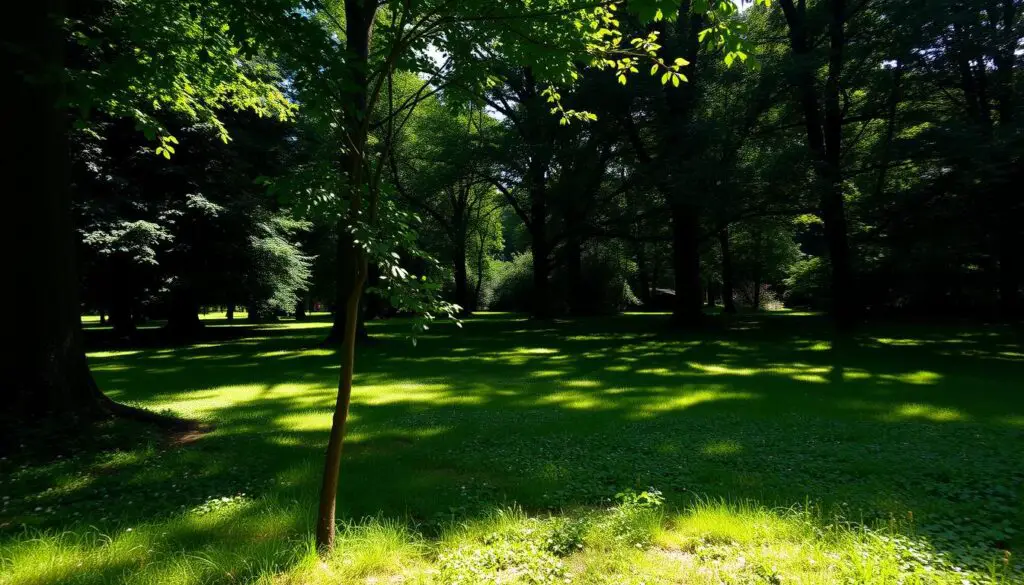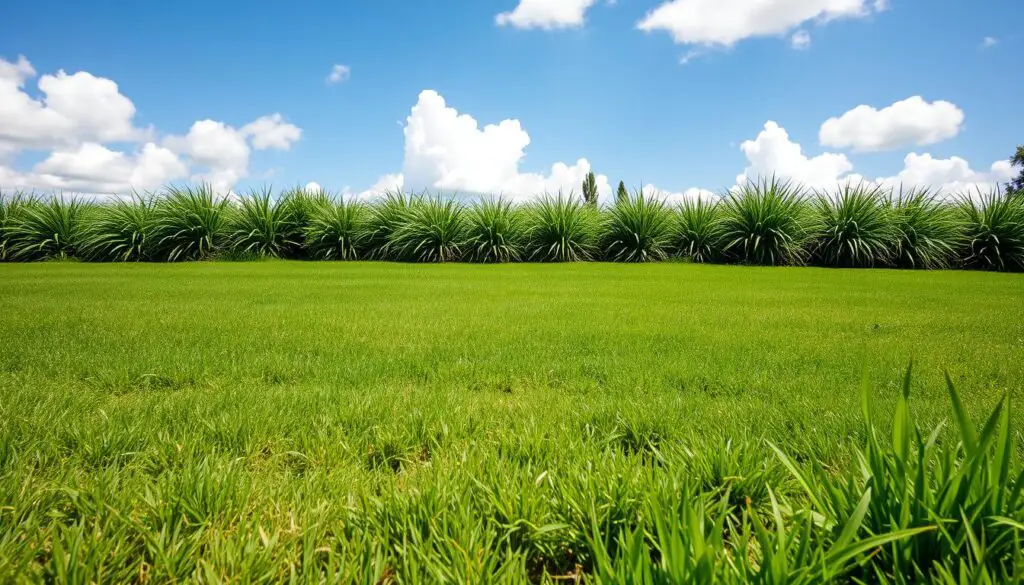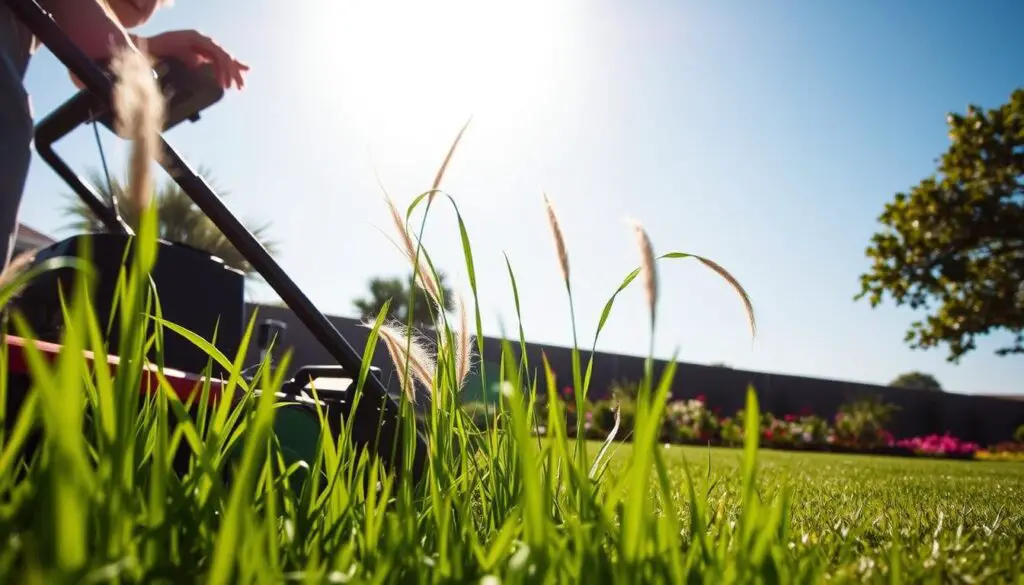How Often Should You Mow Your Lawn?

Did you know mowing your lawn every 7 to 10 days is best? This might surprise you, given how often some people mow. But, the secret to a lush lawn is knowing the right mowing schedule. This depends on your grass type, the weather, and your lawn care habits.
Proper mowing is key to a healthy, beautiful lawn. A regular mowing schedule helps your grass grow well, keeps weeds away, and makes your yard look great. In this guide, we’ll cover the best mowing frequency, what affects it, and tips to keep your lawn looking amazing all year.
Key Takeaways
- Mowing your lawn every 7-10 days is generally recommended for optimal lawn health.
- Mowing frequency can vary based on grass type, weather conditions, and lawn care practices.
- Proper mowing techniques, such as cutting no more than one-third of the grass height, are essential for a healthy lawn.
- Avoiding mowing during extreme heat or wet conditions can help prevent damage to your lawn.
- Leaving grass clippings on the lawn can provide natural fertilization and improve soil health.
What Is the Ideal Mowing Frequency?
Keeping the right mowing schedule is key for a lush lawn. The best mowing time changes with grass type, weather, and season. Knowing these factors helps you tailor your mowing routine for the best lawn look.
Factors Affecting Mowing Frequency
Several things influence how often you should mow your lawn:
- Grass type: Each grass type grows differently and needs a specific mowing height.
- Weather conditions: Rain or drought can speed up or slow down grass growth.
- Time of year: Grass grows faster in spring and fall.
General Guidelines for Mowing Frequency
For most lawns, mowing every 5-7 days is best during the growing season. Adjust this based on the factors mentioned:
- Spring: Mow every 7-10 days as the grass grows fast.
- Summer: Mow every 4-6 days to keep the grass at the right height.
- Fall: Mow every 5-6 days as growth slows.
- Winter: Mow every 3-6 weeks, or not at all, depending on your area’s climate.
Always remember to never cut more than one-third of the grass blade at once. This keeps your lawn healthy and looking good.
“Proper mowing frequency is essential for a healthy, lush lawn. By adjusting your schedule based on the season and grass type, you can keep your yard looking its best all year round.”
Optimal Grass Heights for Common Grass Types
Keeping your grass at the right height is key for a healthy lawn. The best mowing height depends on your grass type. Here are the top heights for common grasses in the U.S.:
- Fescue: 2-3 inches
- Bluegrass: 2-2 1/2 inches
- Ryegrass: 1-2 inches
- Bermuda grass: 1-1 1/2 inches
- Zoysia: 3/4 – 1 inch
- St. Augustine: 2-3 inches
- Buffalo grass: 1-2 inches
Proper mowing can cut weeds and diseases by 50% to 80% in tall fescue. But, mowing too low can harm the roots. This makes the grass weaker and less able to handle drought. The University of Maryland Extension suggests the one-third rule. This means never cutting more than one-third of the grass height at once for better growth.
It’s also crucial to keep your mower blades sharp, water deeply but not too often, and mulch grass clippings. These practices help your lawn stay lush and healthy all season.
mowing frequency for Cool-Season Grasses
Keeping your lawn healthy means knowing when to mow. Cool-season grasses like fescue, bluegrass, and ryegrass grow well in spring and fall. They need to be mowed often to stay looking good.
Fescue, Bluegrass, and Ryegrass
Fescues, bluegrass, and ryegrasses need to be mowed every 6-7 days when it’s warm in spring. In summer, when they grow slower, mow them every 8-9 days. As fall comes, mow them every 8-9 days before the first frost.
It’s important to keep your grass at the right length. For these grasses, the best cutting heights are:
- Kentucky bluegrass: 2.5-3.5 inches
- Perennial ryegrass: 1.5-2.5 inches
- Creeping red fescues: 3-3.5 inches
- Turf-Type Tall Fescue: 2-3 inches
Changing the mowing height with the seasons helps your lawn. Lower cuts in fall and spring, higher in summer, keeps it healthy and weed-free. The right timing and frequency of mowing is key for a lush yard.

Mowing Warm-Season Grasses
Keeping your lawn healthy means adjusting your mowing to fit your grass type. Warm-season grasses grow best in southern and southwestern areas. They need different mowing than cool-season grasses.
Bermuda Grass, Zoysia, and St. Augustine
Bermuda, Zoysia, and St. Augustine grasses grow most in summer. They might need more mowing, mainly when it rains a lot. Here are their mowing heights:
- Bermuda Grass: 1.5 to 3 inches
- St. Augustine Grass: 2.5 to 4 inches
- Zoysia Grass: 1 to 2.5 inches
Choosing the right mowing height is key for your lawn’s health. Cutting it too short can stress the grass. This makes it more prone to pests and diseases. The right height encourages deep roots, drought resistance, and a lush look.
You might need to mow more often in the growing season. Cut the grass when it’s one-third of its recommended height. This keeps your lawn looking neat and well-kept.
“Proper lawn care, including mowing at the right height and frequency, is essential for the long-term health and appearance of warm-season grasses.”
Shady Areas and Lawn Alternatives
Mowing frequency changes a lot based on sun exposure. Most grasses love sunlight, but some grow well in shade. Cool-season grasses like fescue and bluegrass do better in the shade than warm-season ones.
For shaded lawns, mowing is different. You should cut the grass by no more than one-third each time. For shaded areas, mow it between 2.5 to 3.5 inches, less often than sunny spots.
Shaded areas can be tough for lawns. Think about using perennial flower beds or a moss lawn instead. These options need less mowing and do well in shade. They can make your yard care easier.

Adjusting your mowing for shaded areas is key. Using different ground covers can make your outdoor space beautiful and easy to care for. It fits well with the shade from trees.
Mowing a New Lawn
Starting a new lawn needs careful mowing. The first cut must be timed perfectly for the grass to grow strong. Experts say wait a few weeks before cutting to help the grass grow denser.
Grass goes through three stages: germination, establishment, and maturity. For new lawns, wait until the grass is 3-4 inches tall before mowing. Not cutting it on time can harm the lawn, making it vulnerable to diseases.
For sod, wait two to three weeks before mowing. This lets the roots grow strong. Always remove only one-third of the grass during each mow. Mow weekly during the growing season to keep the lawn healthy.
- Wait about 4 to 6 weeks after seeding before mowing the new turf when it reaches a height one-third higher than the desired mowing height.
- Avoid cutting wet or damp grass to prevent clumping and ensure even cuts.
- Restrict foot traffic in newly seeded areas for at least a month after germination or until the new lawn has been mowed a couple of times.
- Mowing height for new grass should be between 3 and 3½ inches, and it’s advised to avoid mowing new grass too short, removing no more than ⅓ of its height.
By following these tips, your new lawn will start strong and grow lush and healthy. It will thrive for many years.
Avoiding Mowing Too Low
Keeping the right mowing height is key for a healthy lawn. Mowing too short can harm your grass, affecting its look and life span.
Mowing when your grass is growing can damage the stems and kill it. It’s vital to raise your mower height as new leaves and roots grow. Cutting the grass too short limits root growth, making it weak to weeds, diseases, and harsh weather.
- Fastest growing lawns like Bermudagrass and Tall Fescue may need mowing weekly or twice a week.
- Slower growing lawns like Zoysia might need mowing every 7 to 10 days, while Centipede grass could require even longer intervals.
- It’s recommended to sharpen or replace mower blades at least once a year or when signs of ragged cuts on the grass are noticed.
Choosing the right mowing height is crucial to prevent scalping and ensure healthy grass growth. Different lawn types have specific height requirements for optimal health, so it’s important to familiarize yourself with the needs of your particular turf.

“Mixing up mowing patterns by changing the angle of approach can help avoid compaction damage to the soil from repeatedly rolling over the same areas.”
By following these guidelines and adjusting your mowing frequency, grass length management, and yard maintenance regimen, you can keep your lawn lush, vibrant, and resilient all season long.
Mowing in Hot Weather
When it gets really hot, you need to change how you mow your lawn. Mowing in the heat can be tricky because the grass is already stressed. It’s important to keep your lawn healthy and looking good.
Here are some tips for mowing in the heat:
- Don’t mow when it’s hottest, between 10 AM and 4 PM. Mow early in the morning or late in the evening instead.
- Make your mower cut the grass a bit higher. This gives the grass more shade and helps it lose less water.
- New lawns need extra care in the heat. Try to mow them when it’s about 70 degrees Fahrenheit.
Changing your mowing frequency and timing can help your lawn stay healthy in the summer. A little extra care can make a big difference in keeping your lawn lush and green all season.
“Proper mowing practices during hot weather can make all the difference in keeping your lawn looking its best.”

Adaptable Mowing Strategies for Hot Climates
In places like West-Central Florida, where it’s always hot, you need to adjust your lawn care timeline and turf grooming cycles. Here are some more tips for mowing in the heat:
- Water your lawn 2-3 times a week to keep the soil moist. This helps the grass’s roots stay strong.
- Mow your lawn every 1-2 weeks. This helps avoid stressing the grass too much.
- Check your soil often to keep the pH and nutrients right. Fertilize in early and mid-summer as needed.
- Watch out for pests and weeds. Deal with them quickly to protect your yard maintenance regimen.
By adjusting your turf maintenance routine for hot weather, you can keep your lawn looking great all summer.
Mowing Wet Grass
Keeping a regular lawn mowing schedule is key for a healthy lawn. But, mowing wet grass can cause problems. It can harm your turf maintenance routine and yard’s look.
Wet grass makes blades heavy and can tear when mowed. Wet clippings also clog mowers, causing uneven cuts. Wet soil can get compacted, making it hard to manage grass length and yard grooming cadence.
- Wet grass can cause your mower wheels to leave deep grooves in the soil, leading to an uneven turf grooming cycles.
- Mowing wet grass increases the risk of slipping and falling, which can be a safety hazard.
- Wet clippings can mat down and smother the grass, preventing proper air circulation and moisture absorption.
It’s best to wait until the grass is dry before mowing. This ensures a clean cut and avoids damaging your sod trimming frequency and lawn care timeline.
Remember, patience is key in yard maintenance regimen. Waiting for the right weather keeps your lawn looking great all year.
Managing Grass Clippings
When I mow my lawn, I often wonder what to do with the grass clippings. Mowing can leave windrows or piles of wet clippings on the lawn. But, I’ve found that managing these clippings can really help my turf.
Leaving Clippings vs Collecting Them
Mowing more often helps avoid too many clippings. Leaving them on the lawn can be a good thing. Grass clippings are full of nutrients like nitrogen, phosphorus, and potassium.
When I leave the clippings, they break down and act as a natural fertilizer. This can cut down my need for extra nutrients by 25%. It also saves money and helps protect the environment.
But, if I let the clippings pile up, they can harm the grass. To prevent this, I mow regularly and keep the clippings short. This lets them decompose quickly. A sharp mower blade is key to chopping the clippings into smaller pieces.
If I have a lot of thatch, I might need to collect the clippings. But usually, leaving them on the lawn is good for my turf. It’s a sustainable and beneficial practice for my [https://themowersguide.com/how-long-after-mowing-can-horses-graze/] lawn care routine.

